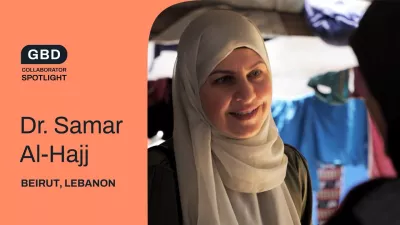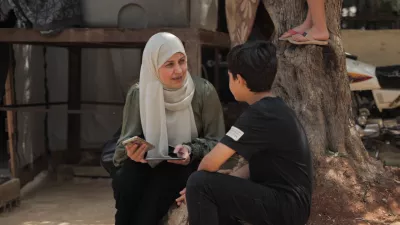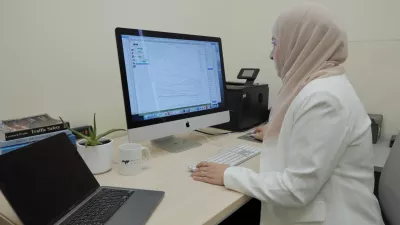Dr. Samar Al-Hajj: Collaborating in Lebanon
Published July 19, 2024

"I am committed to making a positive difference in the MENA region, specifically Lebanon, by reducing the burden of injuries and enhancing the safety of individuals within these communities." -Dr. Samar Al-Hajj, GBD Collaborator
How did you first become interested in working in global health?
My interest in global health stems from the alarming injury situation in Lebanon and the Middle Eastern countries that suffer from a substantial yet neglected burden as a result of routine trauma and the frequent episodes of war and conflict. Witnessing the major health challenges and their impacts on individuals and local communities ignited in me the passion to address the injury problem.
The scarcity of reliable injury data in Lebanon and the Eastern Mediterranean region, along with the limited number of injury researchers further compound the existing knowledge gap in injury research and pose a significant obstacle to understanding and addressing the injury burden.
When did you first learn about the Global Burden of Disease Study (GBD) and what do you work on for the GBD?
I participated in the IHME Global Burden of Disease workshop in 2018 and was fascinated with the wealth of GBD data on various diseases and injuries. Along with international and regional GBD collaborators, we have synthesized GBD data to examine estimates for all types of injuries related to transport injuries, violence injuries, and unintentional injuries for various age groups in the Eastern Mediterranean Region.
We further assessed the burden of child and elderly injury, a critical step toward providing context-specific evidence into the mechanisms and risk factors of injuries to raise awareness, transform attitudes, and reduce injuries in the region.
What are the main types of injuries you study?
As a principal investigator, I have led multiple injury studies with a particular emphasis on intentional and unintentional injuries in the Middle East and North Africa (MENA) region. I extensively studied the epidemiology and prevalence of various injury types, including road traffic injuries, burns, and falls, among pediatric, adult, and refugee populations.
Our research revealed that refugees are at an increased risk of sustaining various types of injuries, particularly burns and road traffic and work-related injuries.
Following the 2020 Beirut Blast, I further examined this mass casualty incident to understand its impact on the population in Lebanon and the fragile health care system. Understanding the injury burden will help to generate evidence-based knowledge essential to develop prevention strategies and to improve safety policies and practices in the MENA region.
Several of the articles you’ve written have pointed out that refugees in Lebanon face heightened risks of injuries, such as road traffic injuries and burns and scalds. How did you get involved with working with refugee communities?
With over a million refugees escaping the war in Syria and settling in camps across Lebanon, often in unsafe and overcrowded tents with substandard living conditions, the need to address their high risk of injuries became evident. I have visited many refugee camps and worked with refugee communities over the last few years, trying to understand the burden of injury in humanitarian settings.
Our research revealed that refugees are at an increased risk of sustaining various types of injuries, particularly burns and road traffic and work-related injuries. Children, in particular, face significant risks of burn and scald injuries due to refugees’ dire living conditions and unsafe cooking and heating practices. Young refugee children often work in hazardous environments without proper safety gear, further increasing their vulnerability to work-related injuries.
Moreover, the camps’ proximity to major highways places refugees at an elevated risk of road injuries as they work in nearby agricultural fields. Through our research and advocacy efforts, we aim to generate evidence, raise awareness, and promote safety to protect these vulnerable populations.

Dr. Samar Al-Hajj's research focuses on understanding injuries and other health challenges in refugee camps.
You’ve worked in many different locations, including Saudi Arabia, Qatar, Canada, and the United States. Can you tell us a little more about your career path and how it led to your current role at the American University of Beirut in Lebanon?
My career progressed at various international institutions and research centers in the United States, Canada, Saudi Arabia, Qatar, and ultimately led me back to Lebanon to fulfill my current role as an Assistant Research Professor at the American University of Beirut.
Upon my return to Lebanon, I founded the Middle East and North Africa Program for Advanced Injury Research (MENA PAIR) to address the burden of injury in the region. I have built an injury network, mobilized national support, and captured primary baseline injury data on pediatrics, adults, and refugees in Lebanon and the Eastern Mediterranean Region.
I’m motivated to leverage my international knowledge and experience in the field of injury prevention to better understand the injury burden in the MENA region, identify the underlying risk factors, and generate data-driven evidence to improve the health and safety of local populations.
Why were you interested in founding MENA PAIR?
I recognized the urgent need to address the burden of injuries, especially in countries affected by wars and conflicts and struggling with limited health care resources. In 2022, I founded the Middle East and North Africa Program for Advanced Injury Research (MENA PAIR), a US National Institutes of Health (NIH)-funded program that builds upon long-standing partnerships between the American University of Beirut and Yale University.
I’m motivated to leverage my international knowledge and experience in the field of injury prevention to better understand the injury burden in the MENA region.
The mission of the MENA PAIR is to advance the science and practice of injury research in the region through training and mentoring PhD, master’s, and diploma-level health professionals in state-of-the-art injury research design, methodology, and analytical approaches to become leaders in injury research in the region and globally.
What are some of the accomplishments of your trainees that you are most proud of?
I am incredibly proud of the accomplishments of our current MENA PAIR trainees as they have demonstrated remarkable dedication and commitment to conducting impactful research that addresses various injury types including traumatic brain injuries, road traffic injuries, and elderly falls. I look forward to witnessing their continued progress and the positive changes they will bring to their communities through injury research and advocacy efforts.

Dr. Samar Al-Hajj uses the GBD Compare visualization to analyze health data.
What has been the most rewarding project you have worked on in your career and why?
One of the most rewarding projects in my career has been leading the National Child Road Traffic Injury study in Lebanon. Road traffic injuries represent a significant problem in Lebanon and the Eastern Mediterranean Region. In this study, we synthesized data from multiple sources (i.e., hospital emergency department records and police reports) to highlight the alarming rate of child road traffic injuries and fatalities in Lebanon. The study revealed that road traffic injuries are the leading cause of death among the youth population, with children under the age of 5 having disproportionately higher rates of death annually.
Evidence generated form this national study was adopted to advocate for child safety. In collaboration with MENA PAIR, Cincinnati Children’s Hospital (USA), YASA (Lebanon), and the National Road Safety Council (Lebanon), we conducted the National Child Road Passenger Safety Workshop in Lebanon in 2022 to raise awareness, educate parents on the use of child restraint systems, and promote the safety of children on the roads.
What impact do you hope your work will have on the communities you study?
I am committed to making a positive difference in the MENA region, specifically Lebanon, by reducing the burden of injuries and enhancing the safety of individuals within these communities. A key area I aspire to impact is reducing road traffic injuries and creating safer road practices through research, advocacy, and the implementation of evidence-based interventions.
Another significant focus of my work is addressing safety and injury prevention in school settings, particularly concussion. I recently launched the Injury and Concussion Awareness, Recognition, and Education (ICARE) Program in collaboration with the Ministry of Education and Higher Education and the Order of Nurses in Lebanon along with the British Columbia Injury Research and Prevention Unit, Child Research Institute Canada. The aim of the ICARE program is to educate school coaches and nurses on how to effectively address and manage injuries and concussions among students. By providing resources, training, and capacity building, I hope that this program empowers school nurses to properly recognize and manage concussions, ensuring the safety of school children.
Thanks for taking the time to answer these questions, Dr. Al-Hajj! Anything else you’d like to tell our readers?
Thank you for the opportunity to share my research work on injury in the MENA region. I would like to emphasize the importance of injury prevention and the collective responsibility we all share in creating safer communities. Knowing that injuries are predictable and preventable, we can reduce the burden of injuries in the MENA region through the implementation of sustainable evidence-based safety policies, practices, and strategies.
